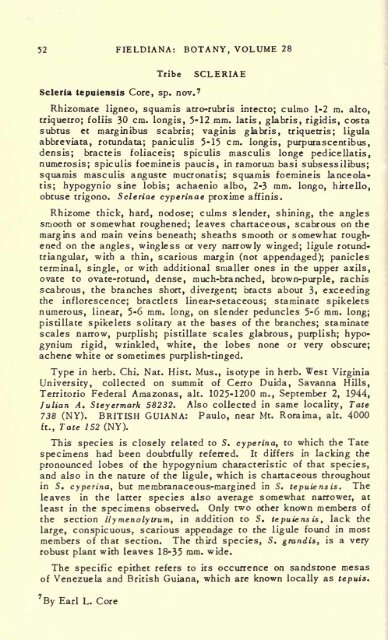PDF - University Library
PDF - University Library
PDF - University Library
You also want an ePaper? Increase the reach of your titles
YUMPU automatically turns print PDFs into web optimized ePapers that Google loves.
52 FIELDIANA: BOTANY, VOLUME 28<br />
Tribe<br />
SCLERIAE<br />
Scleria tepuiensis Core, sp. nov. 7<br />
Rhizomate ligneo, squamis atro-rubris intecto; culmo 1-2 m. alto,<br />
triquetro; foliis 30 era. longis, 5-12 ram. latis, glabris, rigidis, costa<br />
subtus et margintbus scabris; vaginis glabris, triquetris; ligula<br />
abbreviata, rotundata; paniculis 5-15 cm. longis, purpurascentibus,<br />
densis; bracteis foliaceis; spiculis masculis longe pedicellatis,<br />
numerosis; spiculis foemineis paucis, in ramorum basi subsessilibus;<br />
squamis masculis anguste mucronatis; squamis foemineis lanceolatis;<br />
hypogynio sine lob is; achaenio albo, 2-3 mm. longo, hirtello,<br />
obtuse trigono. Scleriae cyperinae proxime affinis.<br />
Rhizome thick, hard, nodose; culms slender, shining, the angles<br />
smooth or somewhat roughened; leaves chartaceous, scabrous on the<br />
margins and main veins beneath; sheaths smooth or somewhat roughened<br />
on the angles, wingless or very narrowly winged; ligule rotundtriangular,<br />
with a thin, scarious margin (not appendaged); panicles<br />
terminal, single, or with additional smaller ones in the upper axils,<br />
ovate to ovate-rotund, dense, much-branched, brown-purple, rachis<br />
scabrous, the branches short, divergent; bracts about 3, exceeding<br />
the inflorescence; bractlets linear-setaceous; staminate spikelets<br />
numerous, linear, 5-6 mm. long, on slender peduncles 5-6 mm. long;<br />
pistillate spikelets solitary at the bases of the branches; staminate<br />
scales narrow, purplish; pistillate scales glabrous, purplish; hypogynium<br />
rigid, wrinkled, white, the lobes none or very obscure;<br />
achene white or sometimes purplish-tinged.<br />
Type in herb. Chi. Nat. Hist. Mus., isotype in herb. West Virginia<br />
<strong>University</strong>, collected on summit of Cerro Duida, Savanna Hills,<br />
Territorio Federal Amazonas, alt. 1025-1200 m., September 2, 1944,<br />
Julian A. Steyermarh 58232. Also collected in same locality, Tate<br />
738 (NY). BRITISH GUIANA: Paulo, near Mt. Roraima, alt. 4000<br />
Tate 152 (NY).<br />
ft.,<br />
This species is closely related to S. cyperina, to which the Tate<br />
specimens had been doubtfully referred. It differs in lacking the<br />
pronounced lobes of the hypogyniura characteristic of that species,<br />
and also in the nature of the ligule, which is chartaceous throughout<br />
in S. cyperina, but membranaceous-margined in S. tepuiensis. The<br />
leaves in the latter species also average somewhat narrower, at<br />
least in the specimens observed. Only two other known members of<br />
the section Hymenolytrum, in addition to S. tepuiensis, lack the<br />
large, conspicuous, scarious appendage to the ligule found in most<br />
members of that section. The third species, S. grandis, is a very<br />
robust plant with leaves 18-35 mm. wide.<br />
The specific epithet refers to its occurrence on sandstone mesas<br />
of Venezuela and British Guiana, which are known locally as tepuis.<br />
tj<br />
By Earl L. Core










![Novellen [microform] - University Library](https://img.yumpu.com/21939450/1/171x260/novellen-microform-university-library.jpg?quality=85)
![Anecdota Chisiana de re metrica [microform]](https://img.yumpu.com/21939448/1/190x239/anecdota-chisiana-de-re-metrica-microform.jpg?quality=85)



![Schollenbruch [microform] : Gedichte - University Library](https://img.yumpu.com/21939437/1/174x260/schollenbruch-microform-gedichte-university-library.jpg?quality=85)
